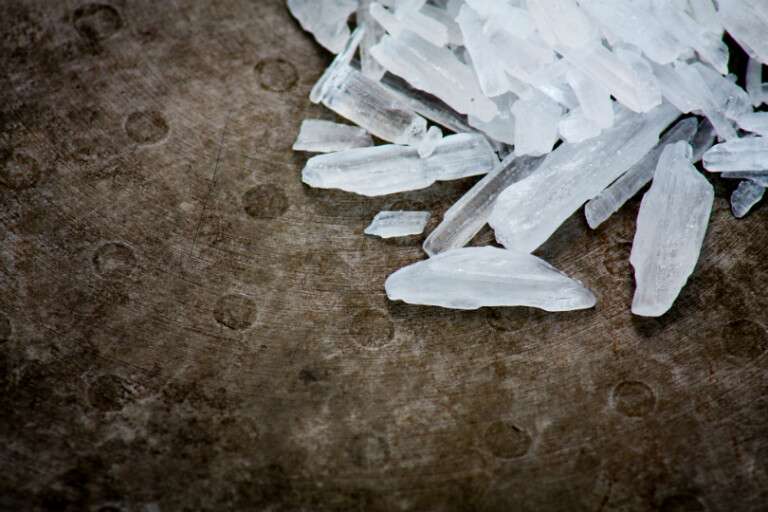Methamphetamine, or meth, is a stimulant drug that can be smoked, snorted, swallowed, or injected. It can be found in powder form or more potently in a rock-like structure known as crystal meth or ice.
Like many other substances, meth can produce a high that lasts for several hours, making the user feel awake and alert. However, the side effects of meth, such as increased heart rate and respiration, overdose, and addiction, can be severe.
Growing use of methamphetamine was reported in the United States and in California from 1999 to 2008, increasing 17% per year in California, according to the American Journal of Public Health. With growing use has come more overdose deaths in California, rising 127% from 2008 to 2013, according to CaliforniaHealthLine.org. This should be concerning for all communities, and education about the dangers of meth use is important in trying to help slow the use of this illegal drug.
How Bad is Meth?
Compared with some other illegal drugs, methamphetamine, also commonly referred to as “meth” or “crystal meth,” is cheap and widely available. Although domestic production has decreased with law enforcement crackdowns on some chemicals used to produce it, meth from “superlabs” in Mexico is trafficked into the US and is especially abundant in the Western states. This has brought prices down and made meth a go-to drug for many who might otherwise use cocaine or heroin.
Meth comes in a crystal form that can be smoked, crushed and snorted, mixed with water and injected or even simply swallowed. The resulting high can last for many hours and gives the user an increased sense of alertness and wakefulness, loss of appetite, increased heart rate and respiration, and increased sexual arousal.
What Is the Scope of Meth Use in the United States?
According to research published in JAMA Psychiatry in 2021, methamphetamine use in the United States increased by 43% between 2015 and 2019. Rates of overdose have risen even more sharply, with researchers from the National Institute on Drug Abuse stating that overdose deaths of stimulants other than cocaine almost tripled from 2015 to 2019, with meth being the primary culprit.
This discrepancy points to increased high-risk use patterns, mixing meth with cocaine, for example, or injecting and smoking meth. The worrying trend calls for greater research and education around the effects of crystal meth and social interventions to prevent meth use from escalating.
Why Is Crystal Meth So Addictive?
Meth is a potent central nervous system stimulant that speeds up activity in the brain. It can make users more talkative and energetic, decrease appetite, and produce a euphoric high.
Many of these effects result from the release of the neurotransmitter dopamine, which is naturally released in the brain as a reward for engaging in life-preserving activities like sex and eating. These pleasurable experiences are then connected with the activity, making users want to do it again.
Taking meth overwhelms the brain with dopamine, producing feelings of intense pleasure that hijack the reward system. Repeated meth use can result in powerful urges that are difficult to resist despite adverse consequences, leading to addiction.
Why Is Meth Bad?
Compared to other illegal drugs, meth is cheap and widely available, making it more accessible than stimulants like cocaine. The U.S. Drug Enforcement Administration classifies meth as a Schedule II stimulant in its list of controlled substances, making it legally obtainable through a nonrefillable prescription.
However, meth is a dangerous drug, and prolonged use can cause severe long-term health issues, mental breakdown, mental health disorders, overdose, and addiction.
What Are the Short-Term Effects of Methamphetamine?
While some people enjoy the immediate effects of meth, others experience negative mental side effects, including:
- Anxiety
- Confusion
- Violent behavior
- Paranoia
- Delusions
- Hallucinations
- Psychotic symptoms
- Physical and mental breakdown
Taking methamphetamine also causes several potentially dangerous or uncomfortable physical effects, such as:
- Increased blood pressure
- Intense itching
- Irregular heartbeat
- Rapid heart rate
- Increased body temperature
- Dry mouth
- Overdose
What Are the Symptoms of Methamphetamine Overdose?
One of the most significant risks of taking meth is overdosing. Ingesting high doses or mixing meth with other substances increases this risk.
Someone who has overdosed on meth may display the following symptoms:
- Seizures or jerking limbs
- Losing consciousness
- Chest pains
- Racing pulse
- Experiences of delusion, paranoia, or confusion
- Severe headaches
- Aggressive behavior
- Dehydration
- Heart attacks
- Stroke
If you are worried that someone has overdosed on meth, you should call 911 immediately.
Effects of methamphetamine
While the user may enjoy the immediate effects of meth, with prolonged or overuse of the drug the user will experience paranoia, delusions, anxiety and confusion. Also, the effects on the cardiovascular system can result in death. In 2017, about 15% of all overdose deaths involved meth, according to drugabuse.gov.
Hospital emergency rooms have reported upticks in the numbers of patients experiencing the effects of meth overdose, which sometimes may be extreme paranoia and delusions resembling a paranoid schizophrenic state, and which can also cause strokes and heart attacks. Some users combine meth with heroin and fentanyl with deadly results.
‘Meth mouth’ and other long-term effects of meth
Long-term use of meth has serious negative effects on the brain and body. Highly addictive, meth changes the chemistry of the brain as it produces surges in dopamine. Users stay awake sometimes for days at a time, foregoing food and sleep as they go on a “run.” The effects of the drug, combined with ignoring nutrition and hygiene, lead to weight loss, itching and skin sores and severe dental problems.
The term “meth mouth” refers to the dental decay that occurs over time in meth users. While high many forget to brush and floss teeth, and often consume soda and candy leading to cavities. The chemicals in meth are also shown to cause bone loss and this affects teeth and roots, which can lead to periodontal disease. Decayed and missing teeth have become an indicator of meth use, and anti-meth campaigns often include photos of meth users with meth mouth.
Tweaking and twitching on meth
Other physical effects are weight loss and twitching, which have become associated with “tweakers,” the slang term for meth users. A skinny, twitching individual will be pegged as a tweaker based on those characteristics. These conditions are prevalent among chronic users, and even after quitting, some people still twitch, as well as suffer from anxiety and paranoia.
Changes in brain function caused by meth use include reduced coordination and impaired language skills, as well as impairment in emotion and memory areas of the brain. These effects are sometimes reduced after a year or more of abstinence, but some effects may never completely be reversed, according to drugabuse.gov.
Dangers of methamphetamine
Criminal behavior also is associated with chronic meth use. Most long-term users become unemployed and instead of a job have a “hustle,” which is usually an illegal means of earning money. This can include dealing, prostituting or stealing. Many tweakers survive by shoplifting or “boosting,” and often have complex schemes involving several people to steal and return items from retailers. Others get involved in identity theft, fraud and forgery. Many end up in the criminal justice system with felony charges and do prison time.
What Are the Dangers of Smoking Meth?
When crystal meth is smoked, it reaches the brain much quicker than oral delivery. This means those who smoke meth will experience a more intense high. However, it also increases the severity of side effects and the risk of fatal overdose. In addition, long-term use can cause lung damage.
What Are the Dangers of Shooting Meth?
Injecting or shooting meth carries the same risks as smoking the drug. In addition, those who shoot meth are often also vulnerable to the risks of shared drug paraphernalia. Sharing or reusing needles can lead to the transmission of blood-transmitted diseases like HIV and Hepatitis C.
What Are the Long-Term Dangers of Methamphetamine?
Long-term use of meth has serious negative effects on the brain and body. Highly addictive, meth changes the brain’s chemistry and produces surges in dopamine. Users sometimes stay awake for days at a time, foregoing food and sleep as they go on a ‘run.’ The effects of the drug combined with ignoring nutrition and hygiene lead to weight loss, itching, skin sores, and severe dental problems.
Get help: Drug Rehab Orange County
The term ‘meth mouth’ refers to the dental decay that occurs over time in meth users. The chemicals in meth are also proven to cause bone loss, affecting teeth and roots, leading to periodontal disease. Decayed and missing teeth can be an indicator of meth use.
Long-term meth use can also cause permanent brain damage. This may involve reduced coordination, impaired language skills, and impairment to the areas of the brain responsible for emotion and memory. According to the National Institute on Drug Abuse, these effects can reduce after more than a year of abstinence, but they may never be completely reversed.
Chronic meth use can lead to a series of other health problems in long-term users, including:
- Liver damage
- Kidney damage
- High blood pressure
- Disturbed sleep patterns
- Mood disturbances
- Mental disorders, such as anxiety and depression
What Is the Link Between Meth and Parkinson’s Disease?
A number of studies suggest a link between methamphetamine use and Parkinson’s disease. While clinical research is limited, methamphetamine use could be a factor in initiating the development of the disease and other risk factors.
Methamphetamine Addiction Treatment
Meth addiction and substance abuse come with alarming risks, and the long-term effects of meth can be devastating. The good news is that addiction is treatable. With the help and support available, many users live a fulfilling, sober life.
To remove all traces of meth from the body, treatment usually begins with medical detox. While stimulant detox does not usually cause life-threatening physical symptoms, it can give way to anxiety and depression, especially during withdrawal. In severe cases, people may develop psychotic symptoms or suicidal thoughts. As a result, twenty-four-hour medical supervision is essential as it ensures that symptoms can be managed and those in recovery remain safe at all times.
Long-term addiction treatment requires more than just detox. Life-long recovery involves identifying the underlying causes of addiction and developing the skills to overcome them. It requires holistic healing of the mind, body, and soul to empower people to reclaim their lives and achieve their full potential.
Addiction centers and rehabs typically offer various treatment options, individualized to fit each person’s needs. These include:
- Cognitive-behavioral therapy
- Individual therapy
- Support groups
- Family therapy
- Complementary therapy
Although treatment helps many people achieve sobriety, the recovery process doesn’t end upon leaving rehab. Those recovering from meth addiction benefit from regular attendance of fellowship groups, outpatient programming, and personal mentors to help them stay on track and achieve their goals.
Contact Us Today
If you or a loved one lives with meth addiction, please contact us today. At Cornerstone, we offer life-changing treatment for substance abuse and addiction to help clients live the fulfilling life they deserve.
Methamphetamine Rehab
Recovery from meth addiction is aided by residential treatment, where the user will have time to detox, and the brain chemistry will begin to normalize. Anxiety and depression are common during the withdrawal period and having a safe place to ride out these feelings is very helpful. Medication prescribed by a psychiatrist may be useful and even necessary for some. The long-term recovery prognosis for meth addicts is good, provided they attend to mental, physical, emotional and spiritual needs.
Cornerstone representatives are available 24/7 and ready to answer your questions about meth addiction and treatment.






